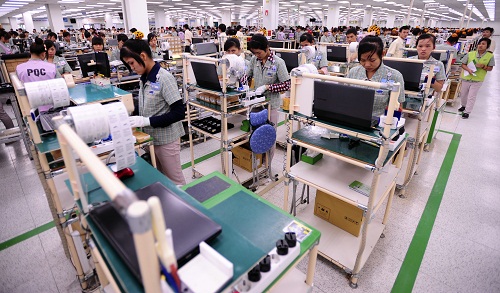Local firms missing out on supporting industry opportunities

Samsung Vietnam (Bac Ninh) -photo VTV
According to the Vietnam Association of Foreign Invested Enterprises (VAFIE), Samsung Vietnam will meet with local businesses producing materials and accessories for the electronics industry next week. Around 100 local companies are expected to join the event.
“Samsung will explain what they need and how Vietnamese companies can engage in their global supply chain,” said VAFIE deputy chairman Nguyen Van Toan.
“If they take this networking opportunity seriously, local firms can get a range of benefits from joining the Samsung value chain, and this could significantly change the face of investment into local supporting industries and the development of Vietnam’s small and medium-sized enterprises,” Toan added.
In fact, this is not the first time a foreign-invested enterprise has taken the initiative in sourcing local suppliers.
For several years now, Japanese companies have held annual fairs to display the products they want to source from Vietnamese suppliers. But the results have been only modest.
The latest survey from the Japan External Trade Organisation (JETRO) shows that Japanese firms buy very few input materials and accessories for their Vietnam production.
The rate was 27.9 per cent in 2012 with a slight increase to 32.3 per cent in 2013, far lower than other regional countries. The rate in Indonesia is 43 per cent, Thailand 53 per cent, and 61 per cent in China.
Moreover, of that supply, most came from foreign enterprises operating in Vietnam. Vietnamese firms only contributed 13.2 per cent of total input materials and accessories sold to Japanese firms.
Foreign firms have also been proactive in preparing for Vietnam’s likely ratification of number of free trade agreements (FTAs) in the coming time.
“To prepare for the Trans-Pacific Partnership (TPP), more than $1.2 billion in foreign investment was poured into Vietnam’s textile and garment sector in the first half of this year. Meanwhile, Vietnam’s leading player in this field, Vinatex, is still frustrated by a series of environmental standards in terms of textile dyeing,” said Tran Huu Huynh, an expert under the Vietnam Chamber of Commerce and Industry (VCCI).
Many developers of foreign fibre, dyeing and export production projects have revealed their interest in investing in Vietnam which came from the opportunities they expect from the TPP.
These factors pose a real threat to Vietnamese firms’ efforts to bolster local supporting industry development.
What the stars mean:
★ Poor ★ ★ Promising ★★★ Good ★★★★ Very good ★★★★★ Exceptional
Latest News
More News
- VIR workshop highlights capital and policy for sustainable development (December 15, 2025 | 11:00)
- National Assembly approves pilot mechanisms to accelerate major projects in Hanoi (December 12, 2025 | 11:29)
- Vietnam eases policy approval requirements, simplifies foreign and outbound investments (December 11, 2025 | 17:53)
- Unpacking new momentum in Vietnam’s M&A market (December 10, 2025 | 09:59)
- Forum honours outstanding M&A deals, strategies, and advisory firms (December 09, 2025 | 18:22)
- Vietnam enters defining phase of M&A growth (December 09, 2025 | 17:00)
- Vietnam’s M&A market opens new opportunities amid strong economic momentum (December 09, 2025 | 15:00)
- Vietnam M&A Forum 2025: new position, new momentum (December 09, 2025 | 14:30)
- FDI in Vietnam jumps on additional capital and share purchases (December 09, 2025 | 13:56)
- VIR gathers dealmakers for M&A forum (December 08, 2025 | 17:17)


















 Mobile Version
Mobile Version